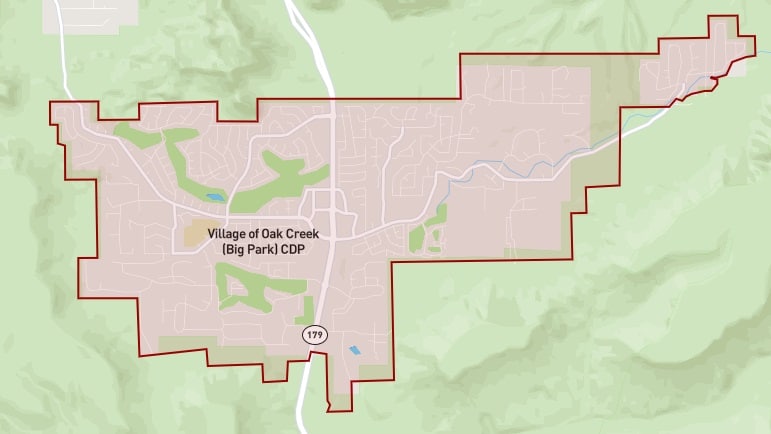Over the years, we have heard many complaints from residents of the Village of Oak Creek about the lack of control they have over their community, be it the construction of a new business; management of State Route 179, Jacks Canyon or Verde Valley School roads; zone changes; or the delay from Yavapai County Sheriff’s Office deputies responding to crime or traffic accidents.
Seeking relief, many Village of Oak Creek residents speak to Sedona City Council or write us letters to the editor addressing council members, asking the city to act or simply addressing city projects.
While postal addresses in the VOC read “Sedona, AZ 86351,” the Village of Oak Creek is not in Sedona city limits. VOC residents are not constituents of Sedona City Council members, a fact some appear not to be aware of until we tell them. While council members may listen to comments or read letters or emails for the sake of curiosity or to gauge regional public opinion, they are not legally nor ethically bound to do anything that benefits the VOC.
The VOC’s legislative body is the Yavapai County Board of Supervisors, which sets policy for the 228,000 people over the 8,123 square miles of the county, so it’s no surprise that the VOC often gets overlooked.
The Village of Oakcreek Association is not a government, but rather a confederation of 25 of the 45 homeowners associations in the area. It has limited power and no authority over parcels outside its jurisdiction. As a private membership organization, VOCA is also not legally subject to Arizona open meeting laws nor public records requests like a government would be.
 The Big Park Regional Coordinating Council is also a quasi-governing agency, but only serves as an advisory body to the county. The county established the BPRCC in 1998 to address issues affecting the Big Park Community Plan area, which consists of the Big Park Core Area, and the Little Park and the Lee Mountain/ Pine Valley planning districts.
The Big Park Regional Coordinating Council is also a quasi-governing agency, but only serves as an advisory body to the county. The county established the BPRCC in 1998 to address issues affecting the Big Park Community Plan area, which consists of the Big Park Core Area, and the Little Park and the Lee Mountain/ Pine Valley planning districts.

There are two ways VOC residents could take local control over the community. The first would be start an annexation effort and join the city of Sedona. A new annexation effort would be a time-consuming and costly process, and would require obtaining consent from both a majority of VOC homeowners and the city of Sedona.

However, the VOC has historically been adverse to incorporation with Sedona proper.
Sedona area residents made two attempts to become a city. The first effort included all of what is now Sedona and most of the Village of Oak Creek connected down State Route 179, but the vote failed 57.3 to 42.7 percent Oct. 15, 1985. The second attempt omitted the Village of Oak Creek and passed Dec. 2, 1987, by 58.7 to 41.3 percent.
If annexed, Sedona’s building codes, sales tax and a host of other rules would have to be applied to the VOC to maintain uniformity throughout the newly expanded city.
The second option is far easier: The VOC could incorporate as its own town or city.
Big Park residents investigated incorporation in 2000 and 2009 but never put the issue to voters.
Incorporation makes sense. The VOC now has grown fast: Its 1990 population of 3,024 has more than doubled to 6,448 residents today. The new town would be more populous than Clarkdale, which only had around 1,500 residents when it incorporated in 1957 and only around 4,200 now.
The VOC could have its own local police force, control its own zoning and elect its own local leaders instead of relying on five supervisors who meet in Prescott and Cottonwood. Like the city of Sedona, the VOC could rely wholly on sales tax to fund its services and never impose a property tax.
The name could be anything. The federal government uses “Village of Oak Creek (Big Park)” as the official Census Designated Place. “Big Park” is the official name from the county. “Village of Oak Creek” is more common, but unless the new town limits reach or include parts of Oak Creek, it might be a bit of misnomer. Residents have suggested calling the area “Bell Rock” after the distinctive landmark while some business owners suggest “Village of Sedona” or “Sedona Village” to piggyback on Sedona’s popularity, but residents could also choose an entirely new name.
Should the VOC incorporate? We’d like to hear your thoughts. Email letters to the editor at editor@larsonnewspapers.com. Letters should be 300 words or less, and include your name, street address and phone number.
Christopher Fox Graham
Managing Editor
From “Municipal Incorporation In Arizona” a 25-page guide published by the League of Arizona Cities and Towns:
PROS AND CONS OF INCORPORATION
In any incorporation movement, careful consideration must be given both to the advantages and disadvantages of this process. Based on our experience with communities considering incorporation, the following is a summary of important arguments, both pro and con, that should be examined carefully before making a final decision.
THE PROS
The most common arguments in favor of incorporation are as follows:
1. Incorporation establishes a city or town government through which a community can express itself, address its problems and supply necessary services to the area. The community can exercise self-determination with regard to the nature and level of local services.
2. Municipal government is more responsive to the people living within the community. The members of the city and town council are closer to the people and, as a result, react more quickly to the community’s requests.
3. A city or town government will receive substantial amounts of state revenues which do not flow to an unincorporated community.
4. An incorporated city or town has additional powers not found in an unincorporated community. An unincorporated community is under the jurisdiction of the county and, as a result, does not have much control over the level of services provided to the residents. The county must provide services as uniformly as possible throughout the unincorporated areas of the county. On the other hand, a city or town council has the authority to intensify services within the community.
5. An incorporated city or town is able to plan for the future growth of the community by adopting planning and zoning regulations which will provide for controlled land use. This regulation protects the community against undesirable land use patterns. In addition, incorporated cities and towns may adopt building, plumbing, mechanical and electrical codes in the interest of public health, safety and welfare.
6. A separate city or town preserves the unity and pride of a particular community and maintains local individuality.
7. As a governmental unit, the city or town can better represent its citizens in transactions with the county, the State and Federal governments. In addition, local government may be used as a vehicle for positive progress in the community.
8. Municipalities may be the instrumentality for providing numerous utility services such as water, sewer, garbage and trash collection, gas and electrical service if the council decides to enter into these operations.
THE CONS
The following are the most common arguments against incorporation:
1. Incorporation is unnecessary because the particular needs of the community are limited in scope. The residents of the community may prefer to organize a special district to meet these limited needs. For example, the community may create a rural fire district to satisfy the necessity for fire protection, or a special district may be formed to fulfill other particular needs such as sewer service. As a result, the special district approach may be more appropriate if the residents of an area want to incorporate only to provide one specific service. However, a special district is not a substitute for incorporation, and the residents of a community should be careful in creating more than one in the same area. The creation of a number of special districts for one area leads to unnecessary levels of government if the area is incorporated at some later date.
2. The separate incorporation of an area which is economically and physically part of a larger community will produce what is known as a “rump” incorporation. This situation can produce an incorporated city or town with inadequate resources or physical facilities necessary to meet its needs. This is particularly true if the character of the community is predominantly residential. A “residential community” may discover after incorporation that its tax base can only maintain a minimal level of public service. In this case, it might be to the community’s advantage to be annexed into an existing city or town or remain unincorporated.
3. The community is too small in either land area or population to serve as an efficient and effective unit of government. It may be difficult, if not impossible, in extremely small areas to provide for an adequate level of services. It may be more advantageous for an area of this nature to receive services from the county.
4. The incorporation of a small area which is an integral part of a larger metropolitan area will create a costly duplication of local services. This situation can lead to a lack of coordinated and orderly urban growth as well as a lower level of such vital services as police, fire, water and sanitation.
5. The area possesses certain rural or farm characteristics which it wishes to retain, and incorporation is an undesirable step towards urbanization.
6. The most common argument against incorporation is that it will increase taxes. In summary, the question of incorporation requires a thorough study by the community. It is to the advantage of all involved if pro and con arguments are fully explained and weighed against each other before the final decision is made.



















